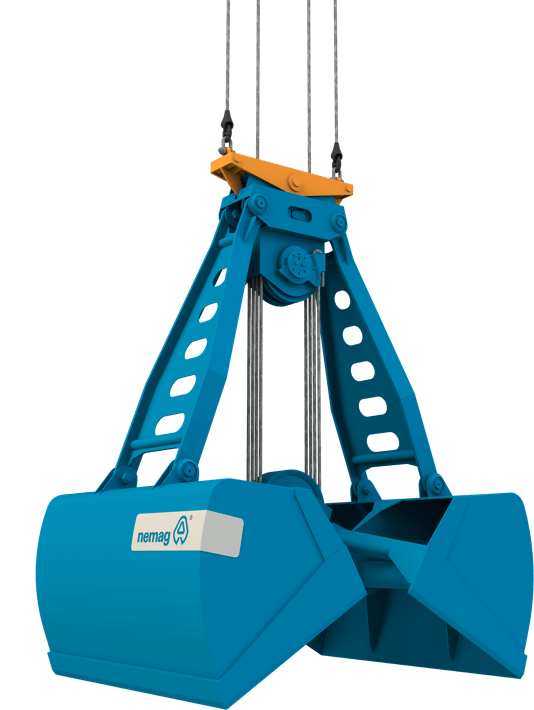The steel industry is a big part of worldwide industrial development. Traditionally, steel production relies on blast furnaces, which consume vast amounts of coal, emitting substantial greenhouse gases and generating considerable waste heat. This traditional process not only contributes to environmental impact but also is energy-intensive and inefficient, especially when turning the furnaces on and off.
Table of contents
1. Why do we see a transition to more sustainable green steel?
2. How does an electric arc furnace (EAF) work?
3. EAF: Switching from coals to scrap, hot briquetted iron (HBI) and direct reduced iron (DRI) as a resource for steel production
4. Adapting grab equipment for EAF requirements
5. The impact of electric arc furnaces and advanced grabs on steel production sustainability
Why do we see a transition to more sustainable green steel?
In response to growing environmental concerns and the urgent need for sustainable steel, the steel industry is witnessing a transformative switch towards zero-emission production methods. A significant factor in this transformation is electric arc furnaces (EAFs). These furnaces offer a greener alternative by utilizing electricity to melt scrap metal, direct reduced iron (DRI) or hot briquetted iron (HBI). These furnaces are not only capable of reducing greenhouse gasses but are also highly efficient because of their ability to be quickly turned on and off, thereby minimizing energy loss.
As part of the broader decarbonization effort within the steel industry, a major focus in 2023 has been on the adoption of new technologies and processes aimed at reducing the industry's carbon footprint. Innovative approaches such as hydrogen-based steelmaking are gaining traction, along with a heightened focus on the production of green steel, which significantly lowers emissions throughout the manufacturing process. This transition to more environmental sustainability is in alignment with global/EU climate targets and evolving regulatory demands. The steel industry is responsible for around 5% of CO2 emissions in the EU and 7% globally. It needs to develop and commercialise new low-CO2 technologies within the next 5-10 years in order to be in line with the EU’s climate targets [joint research centre].
Amidst these efforts, the European Union is taking proactive steps to catalyze innovation in clean steel technologies. The Clean Steel Partnership, launched in June 2021, is at the forefront of this initiative. With a budget of around €2.6 billion required for R&D until 2030, this partnership aims to bring breakthrough technologies up to large-scale demonstration by the end of the decade. It is supported by significant funding, including €700 million from the EU, through Horizon Europe and the Research Fund for Coal and Steel. Moreover, the European Commission’s Innovation Fund, which is financed by the auction revenues of the EU Emissions Trading System, plays a vital role in supporting the demonstration of first-of-a-kind low-CO2 plants.
This strategic focus on clean technology is mirrored by the growth in the electric arc furnace (EAF) market, which is a key enabler of low-emission steel production. The global EAF market, valued at 730.3 million USD in 2023, is expected to expand to 1,473.8 million USD by 2030, growing at a compound annual growth rate (CAGR) of 10.6%. This growth underscores the increasing shift towards EAF technology as an essential component of the steel industry's commitment to sustainable manufacturing practices.
The transition to EAFs significantly impacts steel production operations, particularly in the handling and transportation of raw materials. The switch from primarily dealing with iron ore to managing processed materials like DRI and HBI — or even scrap metal— requires rethinking grab design and functionality and other infrastructure.
With the switch from blast furnaces to electric arc furnaces, have you assessed how this transformation will affect your grab productivity and, ultimately, your operational efficiency?
How does an electric arc furnace (EAF) work?
An electric arc furnace (EAF) is a modern piece of equipment used for steel production that utilizes electrical energy to heat charged material through an electric arc. Unlike traditional blast furnaces that require coal to generate heat, EAFs operate with electricity, making them more adaptable to energy availability and potentially more environmentally friendly. For example:
- Danieli & C. Officine Meccaniche SpA
- Nippon Steel Corporation
- ArcelorMittal
Switching from blast furnaces to EAFs has environmental and economic benefits, as well as benefits for the quality of output:
Environmental advantages
One of the significant environmental benefits of EAFs is their ability to reach operational temperatures much faster due to their quick "on and off" capability. This not only saves energy but also aligns perfectly with the energy grids in places like the Netherlands, where there is often a surplus of energy during peak times. EAFs can capitalize on this surplus, helping to balance the grid by absorbing overcapacity, which is not feasible with traditional blast furnaces that cannot be quickly shut down or restarted.
Economic advantages
Economically, EAFs offer considerable savings in terms of energy costs. The ability to turn the furnaces on only when needed and quickly adjust to changes in electricity prices can lead to more efficient energy use and lower overall production costs.
Quality of output
The output quality of steel from an EAF is highly controllable because the input materials are precisely measured, and the process can be adjusted in real time. Essentially, "what you put in, you get out," ensuring that the quality of steel produced is consistently high and meets specific requirements without the impurities often associated with traditional methods.
Electric arc furnace vs blast furnace
When comparing the traditional blast furnace versus the electric arc furnace, there are a few differences:
Energy consumption
EAFs generally consume less energy than blast furnaces because they can be activated and deactivated quickly, reducing idle times and energy wastage. This ability is particularly beneficial in contexts where energy costs fluctuate significantly.
CO2-emissions
In terms of emissions, EAFs have a lower carbon footprint. Since they use electricity, their direct emissions can be near zero, especially if the electricity is sourced from renewable energy. In contrast, blast furnaces rely on coal, leading to higher carbon dioxide and other pollutant emissions.
Production time
EAFs also have an advantage in production time. They can start production faster and adjust more rapidly to market demands compared to the long and rigid cycles of blast furnaces.
Economic consideration
The cost of electricity for operating an EAF can vary significantly depending on several factors, such as the local cost of electricity, the scale of operations, the efficiency of the furnace, and the production process used. Here are some general points and estimated figures to keep in mind:
Electricity consumption
An EAF typically consumes about 400 to 500 kilowatt-hours (kWh) of electricity per ton of steel produced. This number can vary based on the type of scrap used, the furnace's operational efficiency, and other technological enhancements.
Cost of electricity
The cost per kWh can vary widely based on geographic location, time of use, and the energy contracts a steel mill might have. For instance, industrial electricity prices can range from around $0.06 to over $0.20 per kWh in different parts of the world.
Total cost estimation
Assuming an average cost of $0.10 per kWh and a consumption of 450 kWh per ton of steel, the electricity cost would be around $45 per ton.
Comparison with blast furnaces
Although EAFs have a high electricity requirement, they often have lower overall energy costs compared to blast furnaces. Blast furnaces require coking coal and additional materials, which can be more expensive and less efficient energy-wise. Additionally, EAFs have the flexibility to shut down and restart quickly, potentially allowing them to take advantage of lower electricity rates during off-peak hours.
In terms of operational costs, while EAFs require significant electricity, which can be a substantial cost factor, the overall efficiency and shorter process times can offset these expenses. It's important to consider the cost of electricity and the potential savings from reduced energy consumption over time.
In conclusion, the switch to EAF technology not only aligns with environmental goals but also offers substantial benefits in terms of economic efficiency and steel quality.

EAF: Switching from coals to scrap, hot briquetted iron (HBI) and direct reduced iron (DRI) as a resource for sustainable steel production
The shift to Electric Arc Furnaces (EAF) has significantly emphasized the importance of scrap metal in steel production. EAFs primarily use scrap metal, Direct Reduced Iron (DRI), and Hot Briquetted Iron (HBI) as their source materials. Each type of scrap affects the quality of the steel produced. Traditional scrap metal can vary significantly in composition and cleanliness, directly influencing the steel's final properties. DRI, consisting of small pellets, is known for its purity and uniformity, enhancing the steel's quality. Meanwhile, HBI iron, similar to DRI iron but compacted into briquettes, is more challenging to handle due to its density but contributes positively to the steel’s consistency and strength.
Adapting grab equipment for EAF requirements
The challenges of handling diverse materials for EAF operations, such as varied sizes, densities, and material types (scrap, DRI, HBI), necessitate specific adaptations in grab equipment.
Scrap metal
Scrap metal, being one of the primary raw materials for electric arc furnaces, demands specialized handling equipment due to its diverse forms and sizes. For the effective management of large and irregularly shaped scrap, robust grabs such as the Orange Peel Grab are ideal. This grab is specifically designed to handle the challenging nature of scrap metal, with its multiple tines capable of handling substantial loads securely.
Watch this video where our Orange Peel Grab handles scrap metal in Thessaloniki, Greece:
https://www.youtube.com/watch?v=xfczHt2bzl4
In the case of shredded scrap, which is very fine material, the design of the grab becomes crucial to minimize material loss. These finer materials require grabs that can close very tightly, ensuring that even the smallest pieces are contained and not lost during the handling process. Conversely, bulkier pieces of scrap metal necessitate grabs with the ability to open wider, allowing them to accommodate and effectively secure larger pieces. This adaptability in how far the arms of the grab can open or close is essential and should be personalized to match the specific requirements of the material being handled.
Read our recent post about HMS 1 & 2 en shredded scrap:
Direct reduced iron (DRI)
What is direct reduced iron? Direct reduced iron, commonly pelletized for ease of transport and handling, presents fewer challenges in material handling compared to other forms of steelmaking inputs. Its uniform size and shape allow for a more straightforward handling process. DRI can be efficiently managed using versatile grabs like the NemaX or the lightweight Clamshell. However, personalised adjustments might be needed for both grabs to ensure optimal performance.
For operations that involve unloading pelletized iron ore, the NemaX grab stands out as the preferred option, owing to several significant advantages it offers over more traditional equipment, such as the lightweight clamshell grabs. The NemaX grab is known for its high efficiency, providing at least 10% better performance compared to lightweight clamshell grabs. This increase in efficiency not only boosts productivity but also contributes to notable energy cost savings — around 10% for every ton of material processed. These savings are crucial for steel production facilities looking to enhance their return on investment, not just through increased productivity but also via reduced operational costs.
Additionally, the NemaX grab features the lowest maintenance costs among similar equipment, making it an economically good choice over the long term. Its design ensures a long lifespan for crucial components like closing ropes, further reducing the frequency and cost of replacements.
These attributes make the NemaX an ideal choice for handling DRI, aligning operational efficiency with cost-effectiveness and durability in the demanding environments of modern steel production.
Hot briquetted iron (HBI)
What is hot briquetted iron? Hot Briquetted Iron, derived by compressing direct reduced iron at high temperatures, offers a dense, compact alternative well-suited for use in an electric arc furnace. Its resistance to reoxidation and its uniform size makes HBI a favoured choice for steel producers looking for consistency and quality.
However, handling HBI poses unique challenges due to its high density and hardness, which make it difficult to penetrate. These characteristics necessitate specific modifications to the grabs being used.
Clamshell grab:
The Clamshell grab is often used for various bulk materials and requires significant alterations for HBI. These modifications include the removal of partition plates and an increase in the grab’s weight to handle the compactness and weight of HBI effectively.
Scissor grabs:
The scissor grab, which is inherently heavier, must be made narrower to accommodate the dense blocks of HBI, ensuring a secure grip and efficient handling.
NemaX:
Similarly, the NemaX grab, known for its versatility and efficiency with lighter materials like DRI, also needs adjustments to manage the particular demands of HBI.
In short, the situational context — such as the type of shipping vessels used and the specific conditions at loading and unloading sites — is crucial in determining the appropriate grab modifications. Due to its dense nature, HBI often requires handling procedures that prevent dropping or rough handling, which could lead to material damage or safety issues.
Every aspect of the grab's design and operation must be carefully tailored to the specific characteristics of the raw material to ensure safe, efficient, and effective handling. This includes considering how the grab is positioned, whether it is operating from a ship or on the quay, and the precise requirements of the grab operation to adapt to the unique challenges presented.

The impact of electric arc furnaces and advanced grabs on steel production sustainability
The steel industry's transformative switch to electric arc furnaces (EAFs) marks a significant move towards zero-emission production. EAFs use electricity instead of coal, reducing greenhouse gas emissions and waste heat. This change addresses environmental concerns and supports the global push for sustainable industrial practices.Selecting the right grab equipment for unloading raw EAF materials, is a crucial aspect in this transformation. As the industry shifts from traditional raw materials like coal to alternatives like scrap metal, DRI and HBI, the demands on material handling equipment evolve. The choice of grab — whether it’s an orange peel grab for scrap, a NemaX for uniform DRI, or modified grabs for dense HBI — directly influences productivity and operational efficiency during the unloading phase. Each type of material presents unique challenges that require specifically adapted grabs to handle them efficiently, ensuring minimal loss and maximum throughput.
Wondering which grab is ideal for handling your scrap metal, DRI, or HBI?
Contact us today or directly book a meeting. In a free consultative call, we will help you identify the best type of grab tailored to your specific needs, enhancing your loading and unloading productivity.




